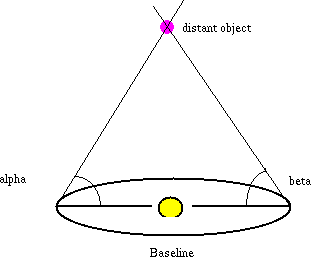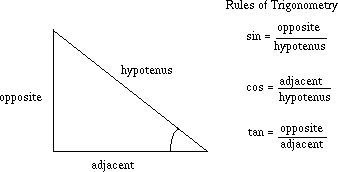
Reading: chapter 1 of the Blue Planet
We look into the sky at night and see stars. We wonder whether there is a boundary to what we see. Is the universe finite, or infinite? Has it always been the way we see it now, or did it have a beginning? Will it have an end?
Problem: If the universe is infinite - no problem (except that it is infinite!)
If the universe is finite - then it must be expanding or contracting; a static universe would collapse upon itself from the Law of gravity.
How can we test these ideas? If any of the above are true, what would we expect? What can be observed which would disprove the above.
In an expanding universe, all objects are moving away from one another. We would expect that the furthest objects would be moving the fastest. So we need to measure velocity and distance to lots of stars and galaxies and see if this is true.
When you can't use a measuring tape or some other physical means to measure distance, it can be done using a method called "triangulation" as illustrated here:

Knowing the length of some "baseline" (say the diameter of the Earth's orbit), and measuring the angles (alpha and beta) to the galaxy (shown as the purple dot) at each end of the baseline, one can calculate the distance to the galaxy using the rules of trigonometry:

To measure the velocity of speeding objects, we can use what is called the "Doppler Effect". Shorter wavelength sound waves are percieved by humans as being higher in pitch.
When a siren mounted on a police car approaches us, the sound waves are squished together and the resulting higher frequency of sound reaching our ear sounds higher.
When the car passes us, the sound drops. If we knew the actual pitch of the siren, we could calculate the velocity of the car from the distortion in pitch. NB: velocity means both speed AND direction!
But we can't use sound waves in space (it's a vacuum!). We could use something like the Doppler Effect using light from stars and galaxies instead of sound.
Light can be separated into different wavelengths by a prism:

Red is the color of the longest wavelength that we can see and violet is the shortest. Objects moving away from us would have light that was shifted toward the Red - an effect known as the "Red Shift".
So we need to measure the wavelengths of light received from the galaxies and see if it is shifted toward the violet (coming toward us) or toward the red (moving away) and if so, by how much.
But in order to determine the true wavelength, we need some reference.
Fortunately, when light from stars passes through the body of the star, (mostly hydrogen and helium), light at certain wavelengths is absorbed, leaving "holes" or dark spots iin the spectrum called "spectral lines". From laboratory experiments on hydrogen and helium, we know exactly what the wavelengths of the "holes" should be.
If the object (star or galaxy) producing the light is moving away from us, then the spectral lines will be shifted to longer wavelengths or to the more "red" part of the spectrum. Thus the so-called Red Shift observed in spectra from distant galaxies can be used to measure velocity.
Once all this stuff is measured (distance and velocity), we make a plot to see if it is true that the farthest objects have the highest velocity or not:

This plot shows that indeed the most distant objects are moving the fastest, consistent with the hypothesis that the universe is expanding. Not only that, we can also tell how long it has been expanding by dividing the distance (cm), by the velocity (cm/sec) and get the age of the universe (in seconds).
From the data shown in the picture, we can calculate that it began expanding some 15 Billion years ago (give or take 5 Billion!).
This idea of the exploding universe is called the Big Bang Theory.
The tiny new-born universe was an incredibly hot mass of almost equal parts of matter and anti-matter, created from energy via the well known equation E=mc2. Matter and anti-matter annihilate one another when they collide, so that is what they did until only matter remained.
At the end of the first three minutes, particles such as protons, neutrons and electrons were stable and began to bang into one another. Protons are positively charged, massive particles that together with neutrons (which have no electrical charge) make up the nucleus of atoms. Electrons are very light, negatively charged particles that scoot around in orbits around the nucleus.
Electrical charges of the same sign repel one another. Protons are positively charged and therefore tend to fly apart, unless they get very very close to one another. If this happens, another force takes over and they stick to one another. The trick is that they have to collide with a tremendous speed to overcome the electrical force trying to keep them apart. This only happens at very high temperatures (60 million degrees or so).
After the first three minutes after the Big Bang, things were cool enough for protons, neutrons and the like to exist but still hot enough for them to bang together and stick. However, with continued expansion, the universe cooled down and only about 10% of the protons were able to stick together to form helium (and a very tiny bit of other heavier elements). By weight, the universe was originally about 24% He and 76% H (with that tiny bit of somewhat heavier elements).
The universe didn't expand uniformly in all directions, but had patches with more and less material. A picture of microwave radiation taken by the COBE telescope reveals the texture of the early universe. These clumps collapsed eventually to form galaxies as seen in the deep field view from the Hubble Space Telescope.
The first stars formed and began to burn hydrogen to make helium. After the hydrogen is used up, the star contracts, heating up the interior enough so that helium burning can begin. If the star is large enough, the force of gravity is strong enough to burn heavier and heavier elements. In this way, elements up to iron can be made.
In the next lecture we will see how the elements heavier than iron were made, and how the solar system was born.